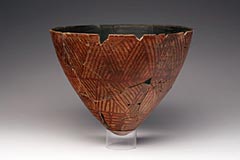 The dawn of the civilisation
The dawn of the civilisation
At the end of the 4 th millennium in the vicinity of the First and
Second Cataracts a new culture, today called A-Group (or A-Horizon),
appeared. A major role in its development must have been played by
significant cultural influences from Upper Egypt, where the beginnings
of the ancient civilization of the pharaohs were being established
at the same time. Apart from animal husbandry, trade became the source
of the group's wealth: in exchange for skins of wild animals, gold,
ivory, ostrich eggs and feathers as well as precious ebony wood, the
inhabitants of what was to become Egypt offered copper tools, foodstuffs
(oil, honey and beer) and above all pottery of highest quality.
Elephantine - "Elephant Town"
The development of trade enriched the local tribal chieftains
and helped the penetration of Egyptian culture and religion into Nubia.
To carry out trade with the south, an Egyptian factory was established
on the island of Elephantine (ancient
Abu , "Elephant Town",
modern Aswan). Soon however, Egyptians started to wage war against the
inhabitants of Lower Nubia - one of such conflicts seems to be memorialized
in a graffito at Jebel Sheikh Suliman near Wadi Halfa, where the name
of pharaoh Djer is accompanied by an image of a bound Nubian chieftain.
Possibly, due to the changes in the Egyptian policy towards the south
during the 1 st Dynasty (ca 3000 - 2890) most A-Group settlements were
abandoned.

